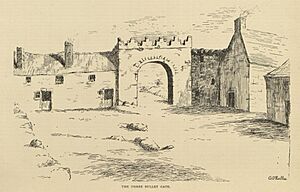Battle of New Ross (1798) facts for kids
Quick facts for kids Battle of New Ross |
|||||||
|---|---|---|---|---|---|---|---|
| Part of the Irish Rebellion | |||||||
 "Battle of New Ross" by George Cruikshank (1845) |
|||||||
|
|||||||
| Belligerents | |||||||
| Commanders and leaders | |||||||
| Strength | |||||||
| 2,000 | 3,000 | ||||||
| Casualties and losses | |||||||
| c. 230 | c.1,000–2,800 | ||||||
The Battle of New Ross was a major fight that happened in New Ross, County Wexford, during the Irish Rebellion of 1798. It was fought between Irish rebels, known as the Society of United Irishmen, and government soldiers who were protecting the town.
The rebels had recently won a victory and wanted to spread their fight. They tried to capture New Ross, a town on the River Barrow. Their goal was to move across the river and bring the rebellion into County Kilkenny and the area of Munster.
Contents
Getting Ready for Battle
On June 4, 1798, the rebels moved their camp. They went from Carrigbyrne Hill to Corbet Hill, which is just outside New Ross. This battle became one of the most intense fights of the 1798 rebellion.
The battle started early on June 5, 1798. About 10,000 rebels, grouped in three columns, attacked the town. The government forces had expected this attack. They knew it was coming since the rebels took Wexford town on May 30.
The town's defenders had about 2,000 soldiers. They prepared strong defenses both outside and inside New Ross. They dug trenches and placed soldiers there. Cannons were set up to guard the streets. This was to stop the rebels, who mostly used long spears called pikes.
The Battle Begins
Bagenal Harvey, a leader of the United Irishmen, tried to make a deal. He wanted the town to surrender peacefully. He sent a messenger named Matt Furlong with a white flag. But government soldiers killed Matt Furlong as he approached.
This made the rebels very angry. An advance group of 500 rebels, led by John Kelly, charged forward. They were told to capture the Three Bullet Gate. They were supposed to wait for more rebels before going further into town. To help their attack, the rebels first drove a herd of cattle through the gate.
Another group of rebels attacked the Priory Gate. But a third group pulled back from the Market Gate. They were scared by the strong defenses there. Seeing this, the government soldiers sent cavalry out the Market Gate. They tried to attack the rebels from the sides.
However, the main rebel army had not yet fully moved forward. When they saw the cavalry, they quickly got ready. They stood their ground and stopped the cavalry charge with their massed pikes.
Fighting in the Town
The rebels, now feeling stronger, pushed past the government outposts. They captured the Three Bullet Gate. This made the government soldiers and people in the town panic and run.
Without waiting for more fighters, the rebels rushed into the town. They attacked down the steep streets. But they met strong resistance from the well-prepared soldiers. These soldiers had good weapons and a second line of defense.
Even with many losses, the rebels managed to take two-thirds of the town. They used smoke from burning buildings for cover. They almost pushed all the government forces out of New Ross.
However, the rebels had very little gunpowder and ammunition. This meant they had to rely mostly on their pikes. This made their attack less effective. The government soldiers managed to hold on. More soldiers arrived to help them. Before noon, they launched a counterattack. This finally pushed the tired rebels out of the town.
During and after the battle, government forces killed captured and wounded rebels. For example, 69 rebels were burned alive in a large house on Mary Street. This house was being used as a rebel aid station. An officer named James Alexander wrote that the screams of the men could be heard over the battle noise. Reports of these terrible acts may have led to the killing of over 100 loyalists in the Scullabogue Barn massacre.
What Happened Next
It is thought that between 2,800 and 3,000 rebels died in the Battle of New Ross. About 230 government soldiers were killed, wounded, or went missing. A priest in New Ross wrote in a church book that about 3,000 rebels were killed. Another witness said that 2,806 rebels were killed. This number might be quite accurate, suggesting someone tried to count them.
Most of the dead rebels were thrown into the River Barrow. Others were buried in a large grave outside the town walls a few days later.
The remaining rebels regrouped and set up a camp at Sliabh Coillte. This was about five miles (8 km) east of New Ross. They never tried to attack the town again. Later, on June 20, 1798, they fought a group of soldiers led by John Moore at the battle of Foulksmills. But they were defeated there too.
Images for kids




